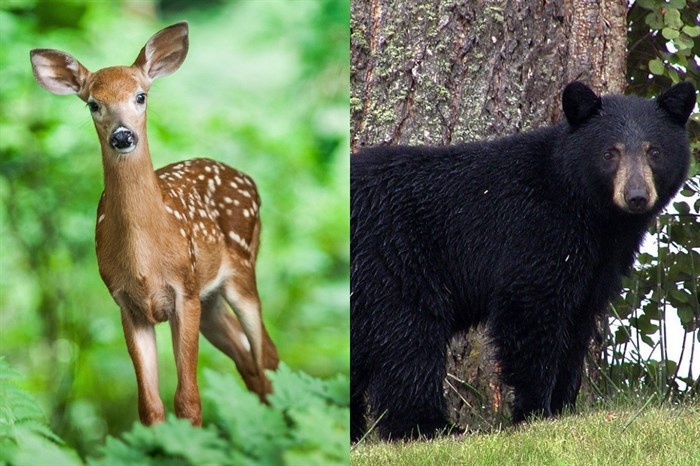
Deer reports are increasing in the Central Okanagan's Westside and there was an unusually high number of bears in the springtime reported in 2020.
Image Credit: Pixabay
January 14, 2021 - 10:00 PM
Over the last five years, deer reports in the Central Okanagan's Westside have been increasing and 2020 saw an unusually high number of bear-related conflicts in the springtime.
“This year, black bears continued to be the most reported species to the Conservation Officer Service, with a total of 245 reports (Jan. 1-Oct. 31), followed by deer and then coyotes.
“Unusually this year, the bear conflict peaked in the spring rather than the fall, with 154 reports in June, which is four times the monthly average of the previous four years,” according to WildSafeB.C. Okanagan Westside coordinator Meg Bjordal, in her latest report.
WildSafeB.C.’s program covers West Kelowna, Westbank First Nation, Peachland and the Central Okanagan West Electoral Area.
Last year's 245 bear reports are slightly above the average number of reports in the last five years, but 154 reports, more than half of the year’s total, were recorded in June which is four times higher than the monthly average of 37, Bjordal reported.
READ MORE: Huge spike in bear sightings reported in West Kelowna area
The province reported an average number of black bear reports for the year.
It is not possible to provide definite explanations to the high number of reported bears during that month, but a few likely factors include a cold spring making natural forage slow to develop, keeping bears at lower elevations where the communities are, more people at home due to COVID-19 may be noticing and reporting wildlife, high bear population numbers and food sources, according to the report.
“Two yearling cubs around the Shannon Lake golf course (were) frequently sighted while they were gaining independence from the sow, and had access to a lot of unnatural food sources in surrounding residential areas,” Bjordal said in her report.
Typically, fall is when the highest amount of bear reports occur in Okanagan Westside communities, due to bears entering a period of intense eating, called hyperphagia, in order to prepare for winter denning.
“However, this fall had a very low amount of reported human-bear conflicts compared to other years. This may be in part to the (Conservation Officer Service) having to destroy approximately nine human-habituated and food-conditioned bears from the communities this year. Garbage continues to remain the most reported attractant in Okanagan Westside communities,” according to the report.
Bjordal said via email that there are too many unknown factors to determine if this trend will continue.
Sgt. Jeff Hanratty, with the Conservation Officer Service, said this month doesn’t appear to be any busier in terms of wildlife sightings than compared to last year.
Garbage continues to be the bear’s main attractant.
In 2020, WildSafeB.C. also reported the highest number of deer reports recorded in the last five years, a continuing upward trend, and 86% of the deer reports were regarding injured/distressed, dead or confined deer, and these are related to vehicle collisions or getting stuck or injured by human structures such as fences.
Conservation Officers spoke about the dangers of wrought iron fences for deer last month, and recently the City of Kelowna has passed a bylaw prohibiting their construction on future developments.
READ MORE: Conservation service repeats warning after deer impaled on fence in Okanagan
To contact a reporter for this story, email Carli Berry or call 250-864-7494 or email the editor. You can also submit photos, videos or news tips to the newsroom and be entered to win a monthly prize draw.
We welcome your comments and opinions on our stories but play nice. We won't censor or delete comments unless they contain off-topic statements or links, unnecessary vulgarity, false facts, spam or obviously fake profiles. If you have any concerns about what you see in comments, email the editor in the link above.
News from © iNFOnews, 2021